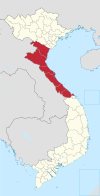Quảng Trị
You can help expand this article with text translated from the corresponding article in Vietnamese. (October 2023) Click [show] for important translation instructions.
|
Quảng Trị
Thị xã Quảng Trị | |
|---|---|
| Quảng Trị Town | |
 The Quảng Trị Citadel built in 1824 | |
 | |
| Coordinates: 16°44′49″N 107°11′40″E / 16.74694°N 107.19444°E | |
| Country | |
| Region | North Central Coast |
| Province | Quảng Trị |
| Established | 16 September 1989 |
| Area | |
| 74 km2 (29 sq mi) | |
| • Urban | 8.27 km2 (3.19 sq mi) |
| Population (2019) | |
| 23,356 | |
| • Density | 315/km2 (820/sq mi) |
| • Urban | 19,390 |
| • Urban density | 2,300/km2 (6,100/sq mi) |
| Time zone | UTC+7 (ICT) |
Quảng Trị (ⓘ) is a district-level town in Quảng Trị Province in the North Central Coast region of Vietnam. It is second of two municipalities in the province after the provincial capital Đông Hà.
History
[edit]The Sino-Vietnamese name Quảng Trị (廣治) was given by Vietnamese Confucian administrators.
A major feature of the town is the Quảng Trị Citadel, built in 1824, as a military bastion during the 4th year of the reign of Minh Mạng. It is an example of Vauban architecture and it later became the administrative head office of the Nguyễn dynasty in Quảng Trị Province (1809–1945).[1]
Quảng Trị was an area of early Catholic presence and by 1913, the nearest railway station to the starting point of the La Vang pilgrimage.[2]
During the Vietnam War, when the province was the South's border with North Vietnam, it suffered a major attack in the January 1968 Tet Offensive and it was the only South Vietnamese provincial capital to be captured by the North Vietnamese forces in the 1972 Easter Offensive before being recaptured in September 1972. During the Vietnam War the city became what some regard as the most bombed city in the world.
Notable residents
[edit]- Hieu Van Le, Governor of the Australian state of South Australia, was born here in 1954.
- Vân Khánh (born 1978), folk singer
References
[edit]- ^ Quang Tri Citadel Vietnam Tourism Information Vietnam Tourism Association
- ^ Catholic Vietnam: A Church from Empire to Nation Charles Keith - 2012 -- Page 164 "... the La Vang pilgrimage were new modes of travel, communication, and publicity. In 1913, the future bishop Hồ Ngọc Cẩn wrote an article in Nam Kỳ Địa Phận giving directions to pilgrims coming to La Vang on the newly built colonial railway.... get off (Quảng trị), what roads to take to get to Cổ Vưu (the starting point of the pilgrimage), what sights to see along the way ...
External links
[edit]16°44′49″N 107°11′38″E / 16.7469°N 107.194°E



